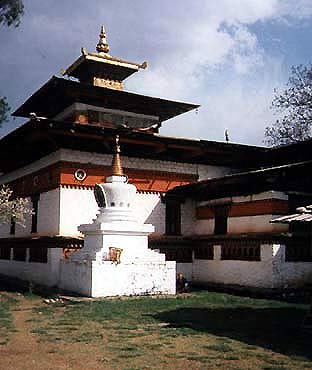  |
 |
Kyichu
Monastery near Paro
| Bhutanese
architecture is famous for its originality, its harmonious proportions
and its adaptation to the landscape. The first recorded buildings
in Bhutanese history were the temples of Lhakhang Karpo and Nagpo in Haa,
Kyichu near Paro and Jampa, Koebnchog-sum and Gayney Lhakhangs in Bumthang,
built around the 6th and the 7th centuries. From the 11th century until
the early 17th century, numerous lamas and their disciples built temples
and monasteries all over the country. From the buildings dating back to
the 17th century that still exist, it can be seen that they were relatively
small structures with a courtyard enclosed within their walls. In most
cases they were only one-storied built close to the temples were the lama's
residence with the quarters for his disciples. Among the most active temple-builders
in the 15th century were Ngawang Choegyal, the great grandfather of Zhabdeung
Ngawang Namgyal, and Tertoen Pema Lingpa. |
|
Fortresses
such as Jathel Dzong, Chelkha Dzong and Dongoen Dzong were built by the
Lhapa Kagyu religious school which once dominated the western
region in the 12th century. In the eastern region, stone castles called
khar were built mostly by the local nobility.
In
the early 15th century, the saint Drubthop Thangthong Gyalpo, who was popularly
known as Chagzampa, visited the country and built iron bridges in different
parts of Bhutan. The architectural landscape changed in the 17th century
when Zhabdrung Ngawang Namgyal introduced the construction of dzongs which
became the model for all monasteries built or restored from that time.
Gangtey Goemba, Dramitse and Tango monasteries are based on the dzong model.
After Zhabdrung Ngawang Namgyal, one of the most active temple builders
was the 4th Desi, Tenzin Rabgye, who at the end of the 17th century had
Taktshang and Tango built in their present form. From the second half of
the 19th century and especially after the earthquake of 1905, temples and
dzongs were restored and palaces were built. The active patrons were Jigme
Namgyal and the successive Kings and their Queens. Some of the best examples
of Royal patronage are the Kharbandi monastery in Phuenbtsholing, the Memorial
Chorten in Thimphu, the new Kyechu Lhakhang in Paro and the newly built
Kuje Lhakhang in Bumthang.
Bhutan's
artistic tradition has its roots in Buddhism with almost all representation
in the arts running along the prevailing theme of struggle between good
and evil. A rare blend of Tibetan, Indian and Chinese traditional styles
in characteristic Bhutanese setting. Bhutanese art is mostly symbolic.
Principally located in monastic centers, it is highly decorative and ornamental.
The Buddhist nature of Bhutan's artistic heritage may be traced to Pema
Lingpa, the great 15th century terton (the treasure discoverer) who was
an accomplished painter, sculptor, xylographer and architect.
In
1680, Desi Tenzin Rabgye opened the school of Zorig Chusum for thirteen
types of Bhutanese arts and crafts under the instructions of Zhabdrung
Ngawang Namgyal. Such promotion of traditional Bhutanese art has persevered
through the centuries with continued patronage provided by the royal family,
nobility and clergy. The common people who depend on the artisans for a
wide variety of metals and wooden objects, indispensable to typical Bhutanese
households, provide active support to the arts. The thirteen arts of Zorig
Chusum area Lhazo (Painting), Shingzo ( Carpentery), Parzo (Carving), Jinzo
(Sculpture), Lugzo (Casting), Garzo (Blacksmith), Tsharzo (Bamboo Works),
Serzo Ngulzo (Goldsmith & Silversmith), Thagzo (Weaving), Tsehemzo
(Embroidery), Dozo (Masonry), Kozo (Leather Work) and Dezo (Paper Works).
Traditional
Bhutanese art is distinctive for its religious flavor and anonymity. The
artist is often a religious man who creates the work commissioned by the
jinda or patron. It is considered a pious act that gains merit for both
patron and artist. Though the artist's name is almost never revealed, the
name of jinda is sometimes mentioned on the work so that his pious act
may be remembered.
Paintings
and sculptures are made by the groups of artists working in special workshops
executed by monks or laymen. The basic preliminary work is done by the
disciples after which the master carries out the finishing touch of the
details.
Traditional
Bhutanese artists work to make a work of faith. They bound by the very
strict iconographic conventions in Bhutanese art and must observe them
meticulously. Artists can, however, express their own personality in minor
details or scenes.
Over
the years, the development of tourism and establishment of a government
school for arts and crafts has brought about a change in the purpose of
art, especially for the younger generation. For some, the desire to make
a living out of art has taken over religious motiv.
|



